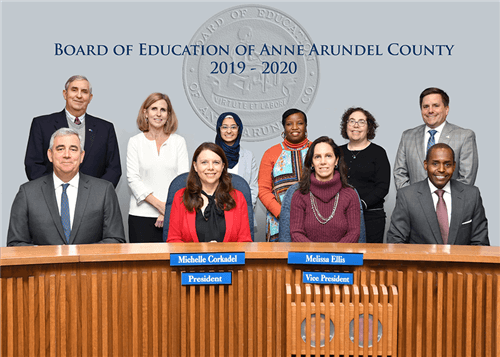Hunger Series: What the President of the Anne Arundel School Board Said

A spokesman for Anne Arundel County Public Schools said that Maryland Matters demeaned Board of Education President Michelle Corkadel when it described her answer to a question as an 11-minute monologue. Below is the transcript of the question reporter Elliot Jaspin asked Corkadel and her reply.
Maryland Matters: Why can’t the schools pay their workers a living wage?
Michelle Corkadell: So, all the wages are negotiated based on the funding availability that the county and the state and the federal government provides for. So, we receive funding as sources at the federal level. We receive funding sources and those also carry through with grants. So when you see the primes you don’t see as much a number of the federal as you do in the backend grants. So, there’s a lot of grant dollars that come in as well. In addition to that then you have the state funding of course, and there’s per-pupil allowances.
There are additional allowances and accommodations through [Maryland Statewide Individualized Education Program] and the Kirwan Commission, of course, is recommending additional state support in targeted areas, including teacher salaries. Not staff salaries, of course, teacher salaries and special education needs and other aspects of mental health and things directly associated with the students. But the bulk of our funding for the teachers and for everything, this is coming directly from the county. And so, the county determines how much through their spending affordability committee how much they are able to spend every single year. Then that number — that projection– that number is what [School Superintendent] Dr. [George] Arlotto and his team use to determine how the budget is allocated. Then we take a flush at it and say do we want to add do we want to subtract from his recommendation?

Michelle Corkadel
There’s not a whole lot of wiggle room because there’s usually a coordinated effort as to – and this is varied from superintendent to superintendent because I used to chair the Planning Advisory Board for the county. So, I’ve got a little bit more knowledge as it relates to how this all plays a part. So just bear with me for a second on the err of siding on too much information because I think it’s very important because the spending affordability with committee will come out in December and tell the county executive here’s how much in capital expenditures that how much you can borrow the bottom bills and out of the capital budget improve the CIP program and then how am I and that’s facilities those long term assets and then how much it remains for the operating budget. And so [former superintendent] Dr. [Kevin] Maxwell when he was in he would throw everything on the wall and say I dare you to take it off and you would be looking at up shots of up to 50% percent of the budget that could not be funded by the county.
Now since Dr. Arlotto has taken in in 2014 at the end of 2014, he has taken a more practical approach in that he works directly with the county executive to determine roughly what ballpark that we’re looking at in advance. That’s just a more prudent approach. But that’s also important to know that what you see is what our starting ball is roughly in the ballpark of where the county executive is going to be able and chooses to fund. The council makes the final decision on funding the school board has absolutely no say to it.
The reallocation of funds has to be within the state designated funding categories because we are a state agency that serves the local government just like the health department does and other similar companions. Social Services is another aspect of that. So, when we’re looking at a budget, we look at a couple things and one is what is the value of based on the position and then secondarily what numbers are available. Most people that are sitting in this category are, you know, they’re hitting in one of three categories. They could be used as a temporary so they could be filling in as substitute teachers. They could — I mean without knowing who the people are where their categories are — they could be temporary help. They could be hourly help.
I have a neighbor across the street and her job was to be a teacher aide. And so she spent about five hours out of every day as a part-time by the hour person going to the schools and making photocopies for the teachers, etc. Her family qualified for subsidized care, but her family also made a choice for her to be home when the kids went off to school and stayed home. So there’s an example of someone who’s made a choice to do that and they sitting in a category outside of where we have direct labor control over. So that person has to be treated just as the stay-at-home mom who wants to help the school. So to speak, the job is to provide copies to the teachers and escort the kids from point A to point B. It’s not a formal position per se outside of its category. And then, of course, we do have our janitor teams and our other staff. Our secretaries are – which I don’t even like using the word secretaries. I think that’s antiquated. But I’ll just say can we strike that and say administrative staff. And in our business units as well as in our support teams, in other capacities those folks are in negotiated agreements.
We have multiple bargaining units representing all of our full-time employees. We have, since we’ve taken office over the last year, have at least last year, we operated under a reciprocity of all units get equal. So when the teachers are negotiating basically the outcomes of that as it relates to steps and [cost of living adjustments] and benefits and leave time and all the other packages Associated and health care has a direct association with how that bargaining unit negotiated with us and it is typically proportionate. So, if you look at last year, we gave makeup steps for the employees who were with us during the recession and there were two, you know, big bubbles during that recession. We took the first bubble because it’s what we knew we could afford and then this year Dr. Arlotto proposed a second bubble group of people and that was to make up for the freeze that occurred with the furlough. But our packages are based on the negotiations and the agreement that all of these employees, if they’re full to truly full-time employees, would have received representation.
So, the state controls the bargaining agreement and how we conduct those and those are conducted under the auspices of what can be afforded and there are provisions that whatever the County Council decides to do that it would be appropriate. So, let’s say the council decides to cut it. Well, then we have to go back in and we have to renegotiate based on what we have. So, we can only propose to a degree what we think would best meet the need and we tend to follow the same industry standards. I’m looking at your numbers and I’m saying OK. Well Montgomery County is also a proportionately at 55, you know, I don’t know what’s going whatever is going on in Prince George’s County and Baltimore County. And if you read yesterday’s newspaper, you can well imagine what else is going on there. Oh, so they have this big upheaval with the leadership based on the new socio-economic profile that has emerged in Baltimore County and they’re having a big brouhaha over who’s going to be in charge and what the mission is And they had a big upset with their superintendent. He got, I guess, I think he had charges against him for some kind of fraudulent act or perjury, I think it was.
Maryland Matters: Is that Darryl Williams?
Corkadell: Yeah, yeah, yeah. That’s the guy’s name. I don’t know the names. I read the articles periodically.
(Editor’s note: Former Baltimore County superintendent Dallas Dance, not the current superintendent, Darryl Williams, ran afoul of the law.)
So yesterday there was a whole new article because they still haven’t been able to vote to get to the seven that they require to determine who the president and vice president is. I feel for every single board member there because it they turned it into a conversation about gaps. They turned it into — I call them opportunity gaps but traditionally called the achievement gap — and how best to address it because their test score numbers went like this and they’re trying to bring them back up. Philosophical differences and a whole host of drama. I’m just glad it’s not part of our school district’s drama.
But that aside I really do think that to really get down to the full story of that, you would have to see where they’re sitting. Because every single employee has representation at that table through that process and that process is established by the General Assembly. And so, you know, we work hard to get as much to them as possible. So, although you may hear a lot from teachers, we are also working with the same bargaining units for comparable packages, and I’m hopeful that we will continue that because that is where the fairness and this perigee that you’re referring to can end up occurring if we’re not very careful about it. But the wages are proportionate to the job descriptions and what the standard is and the labor unions and labor union leadership work to negotiate what a step is and what that step equates to and what that experience means and that a janitor shall start at this salary at this step based on this amount of years of experience that is predetermined and negotiated equally between the employee and the employer. So it is not a case of this is all you get and you have no opportunity to try to get it better. There is a formal process just like with our teachers.



 Creative Commons Attribution
Creative Commons Attribution